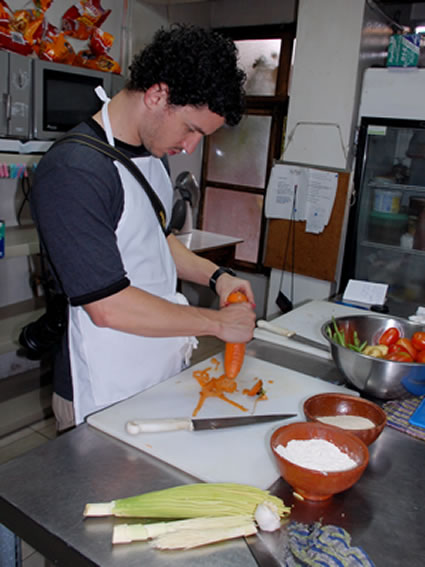Traditional Guatemalan Cooking in Antigua
Article and photos by Lies Ouwerkerk
Senior Contributing Editor
When I lift the doorknocker of Restaurante La Peña de Sol Latino at 8:55 AM sharp, eager to take their Saturday morning cooking class, a cleaning lady answers the door with a surprised “it only starts at 9:00 am!” Nevertheless, she invites me in and offers a delicious Guatemalan cafecito while I await the teacher who is yet to arrive. Welcome to the Latin American pace!
Market
Due to some cancellations, there are only two students, myself included. That turns out to be a blessing, at least for the shopping tour with manager Mayo, as Antigua’s market is huge, crowded, and dark, so it is a lot easier to follow in her wake.
It is in this noisy, chaotic, and colorful market, located on the western fringes of the old town near the chicken bus terminal, where real life happens in otherwise elegant and cobblestoned Antigua, with its pastel-washed colonial architecture and preserved monuments dating from 17th and 18th century Hispanic rule.
In a labyrinth of narrow lanes, vendors have set up stalls with wares from bathroom sinks and electronic devices to pirated DVD’s, toys, clothing, and fruits & vegetables. The vendors stroll around with strings of garlic over their shoulders, or cloth hangers with bras and skimpy underwear hanging from their every pocket. A singer accompanied by a little string orchestra performs between birdcages and meat stalls and sings about lost loves and social injustices.
The market is most lively in the mornings, when many villagers from around Antigua are actively buying and selling. Beware of pickpockets!
Fruits and Vegetables
In the fruit and vegetables section, vendors jostle for our attention with cut-open fruits to show their freshness. When we point to some fruit in particular, like jocote, sour sop, rambutan (lichee) or carambola (star fruit), they are more than willing to explain what it is, and how to cut and eat it.
Beans and corn are the indisputable staples of the Guatemalan diet, and their variety is quite amazing. A totally new vegetable to me is pacaya, which are flowers of a special kind of palm tree. In our cooking class, we will cook them later in boiling water, to kill any bugs and reduce their bitterness, then drape them in a batter of maize flour, salt, and chili powder, and serve them with a tomato salsa.
Only meat and fish are not purchased at the market by the staff of La Peña de Sol Latino, as they prefer to buy at an organic farm in the vicinity of Antigua for safety reasons and freshness.
The Menu
Back in the kitchen of La Peña, we are equipped with an apron, a cutting board, and a kitchen knife and start cutting carrots, green beans, onions, and garlic for the chiles rellenos, chili peppers stuffed with ground beef, rice, beans, capers, and vegetables. The peppers are breaded in an egg batter and fried, and served with a spicy tomato sauce. Then we get ready for the pepian de pollo, a dish steeped in tradition, as the Mayan people already prepared it during religious and political ceremonies more than four centuries ago. While chicken breasts are cooking in a broth with corn oil, cilantro, and salt, we sauté finely chopped tomatoes, onions, garlic, hot (guaque) and regular chilis (pasa) on low heat. Sesame and pumpkin seeds are sautéed in a separate pan at the same time. After all the ingredients from the sauté pans are pureed together in a blender with some salt, pepper, and broth, it is poured over the chicken and served with a portion of rice at the side.

|
More Traditional Dishes
Other traditional dishes that are regularly on the menu of the cooking class are pollo en jocon (chicken in a tomatillo-cilantro sauce), rellenitos (sweetened refried black beans covered by mashed ripe plantains, and then fried), sweet corn tamalitos, and enchiladas.
Fiambre is also a famous traditional Guatemalan dish. Originally, family members would bring favorite dishes of their deceased loved ones to the cemeteries on the "Day of the Dead." Mixed together, these turned over time into huge salads including cold cuts, eggs, sausages, vegetables, cheeses, and olives, now prepared and served on All Saints Day, celebrated on November 1.
Tortillas
Finally, it is time to make the indispensable tortillas that accompany each Guatemalan dish. Our cook Norma learned the art of making tortillas by hand at a very young age from her mother, and now bonds with her 4-year old daughter over making them in their own kitchen.
We use masa, a corn flour that has been treated with lime to make it easier to digest and bring out the most nutritious elements. After adding very warm water to the masa and kneading the dough until pliable and soft, we shape small balls and try to form very thin pancakes by patting them between the palms of our hands. This is far from easy, and although most Guatemalan women know how to prepare fresh tortillas by hand, nowadays they can also be made with roller pins and presses.
Once the pancakes are thin enough, we place them in a pan and cook — 30 sec. on each side — until the tortillas are slightly browned and puffy. Now all dishes are ready, and we can sit down to enjoy a delicious traditional meal!
Lies Ouwerkerk is originally from Amsterdam, The Netherlands, and currently lives in Montreal, Canada. Previously a columnist for The Sherbrooke Record, she is presently a freelance writer and photographer for various travel magazines.
| Related Topics |
|
Culinary Travel
|
|
